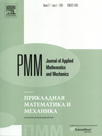 | | Journal of Applied
Mathematics and Mechanics
Russian Academy of Sciences | | Founded
in January 1936
(Translated from 1958)
Issued 6 times a year
ISSN 0021-8928
(print version) |
Archive of Issues
| Total articles in the database: | | 10610 |
| In Russian (ΟΜΜ): | | 9811
|
| In English (J. Appl. Math. Mech.): | | 799 |
|
| << Previous article | Volume 79, Issue 6 / 2015 | Next article >> |
| Kh.F. Valiyev and A.N. Kraiko, "The dispersion of an ideal gas from a point into a void. A new model of the Big Bang and the expansion of the Universe," J. Appl. Math. Mech. 79 (6), 556-565 (2015) |
| Year |
2015 |
Volume |
79 |
Issue |
6 |
Pages |
556-565 |
| DOI |
10.1016/j.jappmathmech.2016.04.001 |
| Title |
The dispersion of an ideal gas from a point into a void. A new model of the Big Bang and the expansion of the Universe |
| Author(s) |
Kh.F. Valiyev (Baranov Central Institute of Aviation Motors, Moscow, Russia)
A.N. Kraiko (Baranov Central Institute of Aviation Motors, Moscow, Russia, akraiko@ciam.ru) |
| Abstract |
A self-similar solution of the problem on the dispersion of a finite mass of an ideal (inviscid and non-heat-conducting) gas that is compressed into a point and has infinite energy and finite entropy is obtained within classical (non-relativistic) gas dynamics. In this solution the gas disperses at once into all space, and, as a result, its thermodynamic functions (including the density), unlike the conserved entropy, vanish. The velocity of the gas obtained is equal to the ratio of the distance to the time, which are measured from the point and time of dispersion, and increases from zero to infinity for any time. In self-similar variables the new solution is described by one of the singular points of the corresponding differential equation, rather than by a segment of an integral curve. It satisfies the cosmological principle, which assumes that the Universe is isotropic and homogeneous with respect to the laws that determine its expansion. The problem of the dispersion of an ideal gas from a point into a void when the gas has a mass proportional to its energy and a fixed number of particles of non-zero rest mass is also solved within relativistic gas dynamics without gravity. Here the pressure, internal energy and enthalpy at a non-zero particle number density instantaneously vanish, and the formula for the velocity of the gas is distinguished from the classical only by the restriction of the speed of light. The velocity of the gas satisfies the cosmological principle in the entire expanding Universe, and the particle number density satisfies it outside of the layer adjacent to its boundary. The gravitational correction is then determined in the classical approximation. For more than 200 NASA versions, the distribution of the gas velocity found without this correction agrees with the lifetime of the Universe and the Hubble constant more closely than all the cosmological theories used by NASA. |
| Received |
23 June 2015 |
| Link to Fulltext |
|
| << Previous article | Volume 79, Issue 6 / 2015 | Next article >> |
|
 If you find a misprint on a webpage, please help us correct it promptly - just highlight and press Ctrl+Enter If you find a misprint on a webpage, please help us correct it promptly - just highlight and press Ctrl+Enter
|
|

 Russian
Russian  English
English